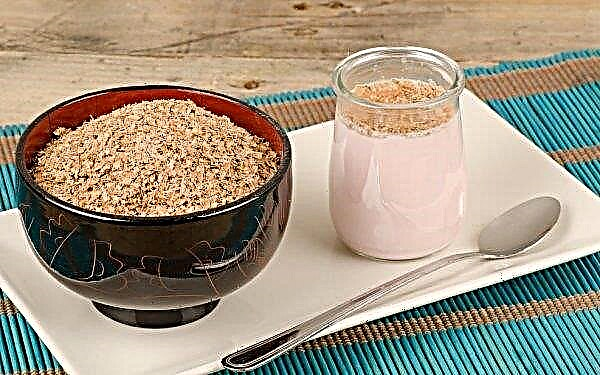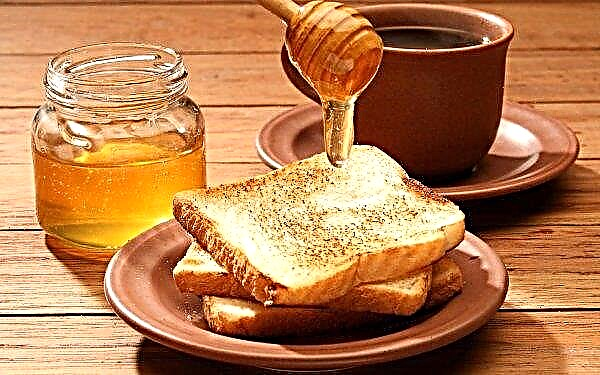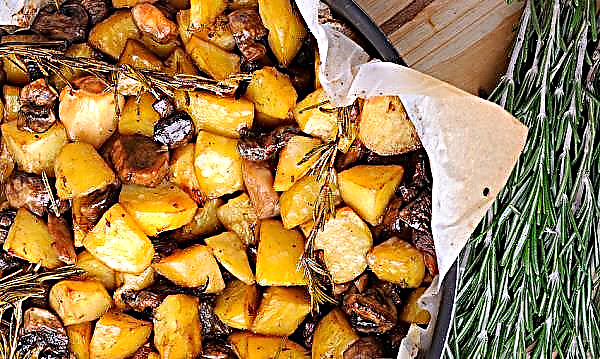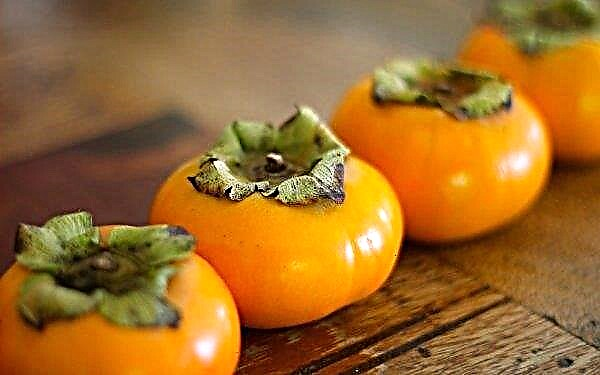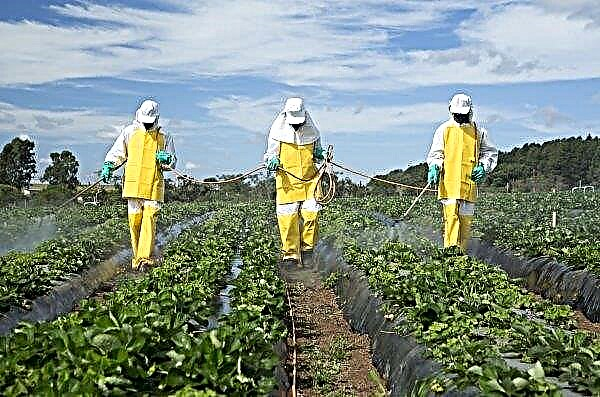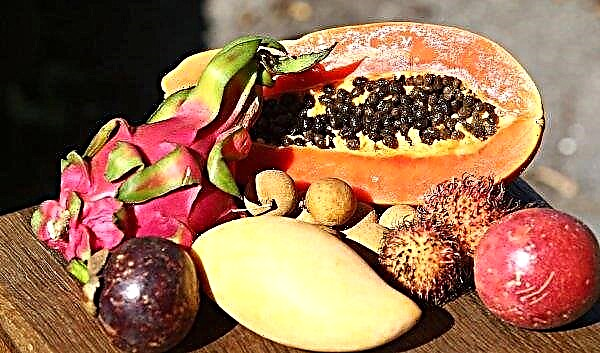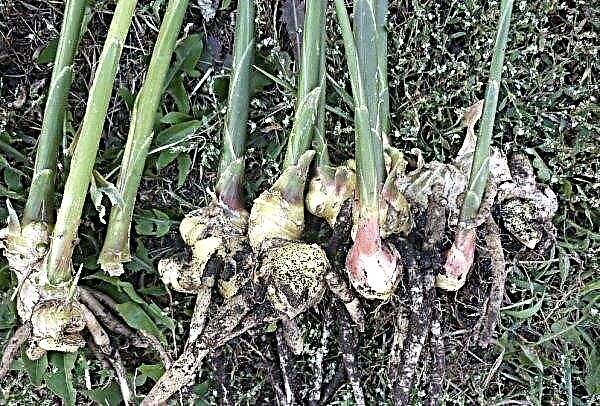The breed of Merino sheep is widely heard by many, since this name is yarn from their wool. This is a popular variety around the world that has no equal in the woolen direction. If you decide to get merino sheep, be sure to study the characteristics of the breed and the subtleties of the content. Further in the article you will find a description of the breed, as well as features of the care and breeding of individuals.
General characteristics and description
Merino sheep - a breed that is bred to obtain wool. These are animals with powerful legs, an elongated head and large horns. Merinos differ from other breeds in fine-fleece wool. The description of sheep and rams varies depending on the variety. Among the merino sheep, the species of fain, medium and strong are distinguished.
- Fine. The subspecies has even skin and a uniform coat of wool. Fleece fayn the most high-quality among all subspecies.
- Medium. There are several folds on the skin of animals. The quality of the coat is lower than that of the files.
- Strong. The specimens of the Strong subspecies are massive, in size they can be compared with meat breeds.

The origin and advantages of the breed
The Merino breed was bred by breeding in Spain in the 13th century. For breeding crossed individuals belonging to the Middle East and North African breeds. By the 18th century, the government banned the export of merino sheep from the country. The punishment for moving an animal across the border was the death penalty. Only after the XVIII century the ban was lifted, and the owners managed to establish exports to other states. In other countries, merinos were crossed with local sheep. So the breed began to have many subspecies.
Did you know? The European fashion house in 2004 acquired 100 kg of natural merino wool for 420 thousand dollars.
- The breed has many advantages in comparison with other species:
- Unpretentiousness. Merinos are easy to care for and breed. Animals do not need a special diet - the standard food for sheep is suitable. Sheep and sheep quickly adapt in a new place and even in a new climate.
- Fertility. High fecundity characteristics in 140% are a definite plus of this sheep species.
- Wool. The main feature of the breed is fine wool. The high rates of shearing and the quality of the material make merinos attractive to farmers.
Why merino sheep wool is considered elite
Fleece of merino sheep is considered one of the most expensive and at the same time demanded natural types of yarn. The material has many remarkable properties, thanks to which it gained such popularity.

The properties
The wool of merino sheep is fine-fleeced. The villi are thin and soft, which makes the yarn warm and pleasant to the touch from the fleece. The main properties of the fleece:
- the fibers are sinuous, while the wool itself is aligned on both sides;
- pile length 8.5–9 cm on average;
- fineness 45–79 den depending on the species;
- beige girotop;
- up to 50% washed fiber.
Beneficial effects on human health
Clothing made of various materials positively or negatively affects human health. For example, synthetic fabrics do not allow heat to pass through, which provokes increased sweating. Clothing made from merino yarn, like from other natural materials, is more preferable than synthetic.
- The advantages of the merino material are even greater, since it:
- retains heat;
- gently touches the skin;
- does not absorb sweat and smells good.
That is why merino wool is popular in the clothing industry.

Productivity Options
The productivity of individuals depends on the particular breed, subspecies and gender. The average values of all merinos are as follows:
- Fain. Males weigh up to 70 kg, give 9–20 kg of rune. Females weigh up to 40 kg, produce 4–10 kg of wool. The quality of the rune is from 70 den.
- Mediums. Males weigh up to 85 kg and give 9–20 kg of rune. Females weigh up to 45 kg and produce 4–10 kg of wool. The quality of the rune is about 65 den.
- Strong. Males weigh up to 95 kg, give 9–20 kg of rune. Females weigh up to 60 kg, produce 4–10 kg of wool. The quality of the rune is about 45 den.

Famous breeds
There are many breeds of merino sheep. The most famous of them are the Australian, Electoral, Negretti, Mazaevskaya, Novokavkazskaya, Rambouillet and Soviet merino.
Did you know? In Australia, a popular contest for cutting merino for a while. Some record holders manage the task in 60 seconds.
Australian
After the export of the breed outside of Spain, some of the individuals appeared on the Australian continent. All subspecies of Australian merino have high wool performance. Australia ranks first in the world for the production of merino fleece. About 70 thousand farms in the country are engaged in breed breeding.

Electoral
The breed Electoral bred by Spanish breeders. The species gained the greatest popularity in Germany. The breed is less productive in terms of the amount of wool obtained. From one adult sheep, farmers receive only 1 kg of fleece. This is due to the short pile, whose length is only 4 cm. Also, these sheep are more whimsical to care for. However, the breed has a plus - a good fineness of hairs.

Negretti
Negretti sheep bred in Germany. The breed has an average wool performance. From one sheep, farmers cut about 4 kg of fleece. A distinctive feature of Negretti is a moderate amount of wrinkles on the skin.

Mazaevskaya
The Mazaev subspecies is the fruit of the work of Russian breeders. The species is common in the North Caucasus region. The wool productivity per year is 6–15 kg per individual. Nowadays, the popularity of the breed has fallen due to genetic degradation. Sheep are often born weak and do not justify the characteristics.

Novokavkazskaya
The Novokavkazsky variety was brought up by the breeder P. Kuleshov, having crossed the Rambouillet and the Mazaev merinos. Animals are distinguished by a powerful constitution and good performance indicators. The average sheep gives up to 6 kg of clipping per year, ram - up to 9 kg.

Ramambulier
Rambouillet is a French breed. The average individual gives about 5 kg of wool per year. Animals differ in strong physique and high-quality soft fleece.

Soviet merino
Soviet breeders were bred by Soviet breeders, crossing the Rambouillet and the Novokavkazsky breed. Individuals are large, powerful constitution, fleshy. The coat has a beige hue.

Rules and Features
The main direction of the content of merino is wool, so the main rule of growing is to control the purity of the rune and timely cutting. Also pay attention to the general welfare of the herd. The tasks of a responsible farmer include monitoring the health of all individuals. For this flock you need to provide quality care.
Care and breeding
Breeding merino impossible without proper care. For sheep, you need to prepare a nightmare, follow a diet, graze regularly, cut, bathe. Also, the farmer needs to monitor pregnancy, lambing and the first months of life of newborn lambs.

Grazing
Animals are grazed from the beginning of spring to the end of autumn. Grazing rules vary depending on the season.
| Spring | Walking is carried out only in dry weather. After the snow melts and during the spring rains, it is not necessary to graze sheep. |
| Summer | Sheep walk from 5-6 to 11 in the morning. From 11 to 5 o’clock in the afternoon animals are driven into a nightmare so as not to expose the coat to intense light. From 5 to 10 pm grazing is again arranged. |
| Fall | Animals walk from 11 to 2 pm. After 4 hours, sheep and rams are again released into the pasture. A flock is driven into a nightmare when it gets dark. |
Koshara for content
For keeping merino need to equip a nightmare. The room must be protected from sudden gusts of wind. Stuffiness should also be avoided. Near the nightmare, farmers are advised to arrange feeding cages. In open-air cages there should be feeders and drinking bowls.

Norms of placement
Rates of accommodation depend on individuals and their number. When equipping a nightmare, consider the following area recommendations:
- sheep - 1.5 m²;
- ram - 2 m²;
- lamb - 0.7 m²;
- sheep with offspring - 2.2–2.5 m².
Diet
Fresh grass is the main source of nutrition for merino sheep from mid-spring to mid-autumn. In grazing animals are limited only by time. However, it is impossible to feed animals by walking alone. This is especially true in winter and early spring, when lambs do not have access to fresh grass. In order to fully provide the herd with the necessary elements, the breeder selects a diet. Specific calculations depend on weight and subspecies.
Important! Silo negatively affects the digestive tract of sheep. Try not to feed animals with such food.
An approximate daily diet is indicated in the table below.
| April May | 350-650 g of concentrate, 0.5 kg of hay, salt and water as needed |
| June August | 200 g of concentrate, hay, salt, water as needed |
| September - November | 1 kg of potatoes or peas, straw, salt, water as needed |
| December - March | 250-400 g of mixed feed, up to 3 kg of potatoes, carrots, peas or apples, hay, salt, water as needed |

A haircut
Since the beginning of the second year of life, merino sheep have been sheared. A haircut is carried out annually in the spring. Before cutting the fleece, the farmer must make sure that the coat is clean and dry. It is advisable to call an assistant for the procedure. In the process of cutting, one person must hold the animal, and the second - to cut the hair. At one time it is necessary to remove the fleece from all parts of the body of the lamb.
Bathing
To maintain the health of animals you need to bathe periodically. The procedure is carried out without fail:
- 2-3 weeks after the haircut;
- after beating the lambs from the mother;
- summer in the heat as needed.
The flock can be driven through a hole with a diameter of 10 m, filled with water. The water level should reach the neck of the lowest individual. In the absence of space for the pit, you can wash the wool with a soft stream of water.

Mating and lambing
Sheep and sheep mate from the second year of life. A pair of animals is released into the enclosure for 2 days, for which the male must cover the female. If pregnancy has not occurred, the mating process is repeated after 2 weeks.
To breed new hybrids, breeders resort to artificial insemination. To do this, ram sperm is injected into the sheep’s vulva using a veterinary syringe.
Important! For the first 5 hours after giving birth, constantly give the sheep water to drink.
Lambing occurs 20–22 weeks after pregnancy. At the time of delivery, it is better to call a veterinarian. Lambing can take place on its own, but in some cases it is necessary to manually break the amniotic fluid and get the lamb. After 10-20 minutes, the newborn will drink mother's milk.

Growing lambs
The first 3 months of young growth is mainly fed by breast milk. From 1 month you can add complementary foods to the diet. As the first food, cereals, grass or mixed feed are suitable. The rest of the lambs will be taken care of by the reared sheep. From 3 months, the lambs are gradually transferred to adult food and accustomed to a common herd.
The cultivation of merino must be approached correctly. It is impossible to get high-quality wool if you do not follow the animals. Having studied the subtleties described above, the farmer will definitely be able to grow a healthy herd and annually collect a large cut.

